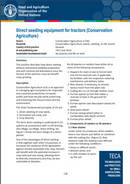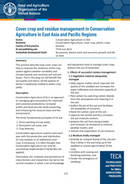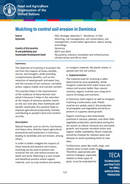Ресурсы

Factsheets - The term direct seeding is understood in CA systems as synonymous with no-till farming, zero tillage, no-tillage, direct drilling, etc. Figure 1 shows the basic design of a direct planter. One of the advantages of direct seeding is that together with other CA practices, it increases the resilience of the agrosystem against climate associated risks. Also, farmers will benefit with the potential increase in crop yield and cost saving, allowing them to diversify investments and thus, be less vulnerable to disasters.

Factsheets - Conservation agriculture systems start each year with the production and distribution of crop residues or an additional cover crop. Erroneously, it is often thought that Conservation Agriculture can only be successfully implemented if herbicides are applied. Fortunately, the creativity and persistence of many farmers and researchers has led to the current situation in which a lot of knowledge and equipment exist to manage cover crops without the use of herbicides.

Factsheets - The objective of mulching is to protect the soil from the impacts of heavy rainfalls, storms, and droughts, while providing complementary benefits, such as the reduction of weed growth and water loss, and the increase of soil moisture, microbial action, organic matter and nutrient content. This practice helps in the improvement of the resilience of those farmers that adopt it because it helps in the reduction of the impact of extreme weather events on the soil. And also, their livelihoods will benefit: eventually, this practice helps to improve agricultural productivity, thereby contributing to people’s food and nutrition security.

Papers - Conservation Agriculture (CA) comprises the practical application of three interlinked principles, namely: no or minimum mechanical soil disturbance, biomass mulch soil cover and crop species diversification, in conjunction with other complementary good agricultural practices of integrated crop and production management. In 2015/16, CA was practised globally on about 180 M ha of cropland, corresponding to about 12.5% of the total global cropland. In 2008/09, the spread of CA was reported to be about 106 M ha. This change constitutes an increase of some 69% globally since 2008/09. In 2015/16, CA adoption was reported by 78 countries, an increase in adoption by 42 more countries since 2008/09, respectively. The average annual...

Publications - This manual is specifically designed to help train actual and potential farm mechanization service providers, in order to increase access to sustainable farm power to raise the productivity of smallholder farmers. It focuses on two crucial aspects: the provision of farm mechanization services as a viable business opportunity for entrepreneurs, and the essential criteria of raising productivity in an environmentally sensitive and responsible way i.e. that includes conservation agriculture. Practical guidance on the essential business development and management skills required to successfully run a mechanization service provision business are presented, with a focus on the equipment required to offer services...
